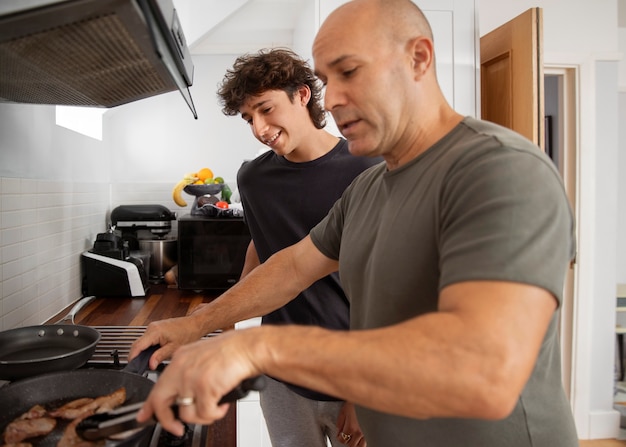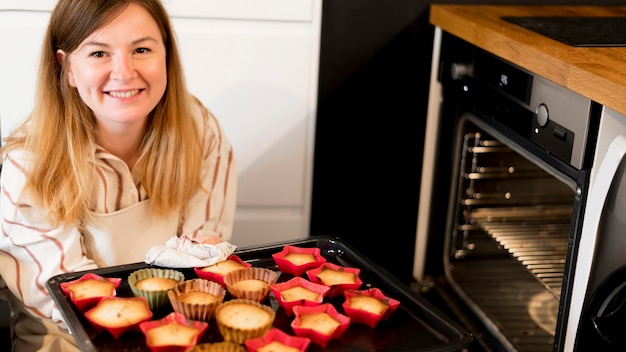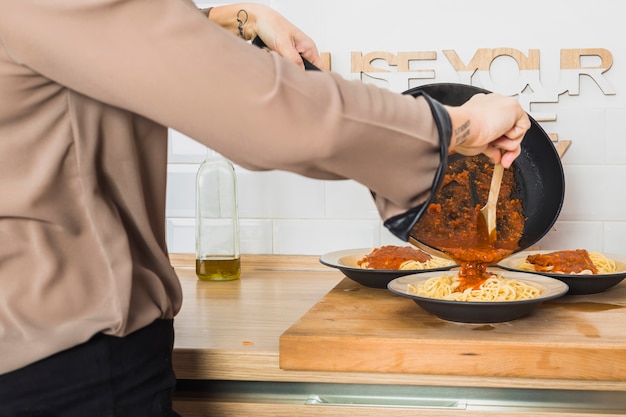Right, let's talk bratwurst. You know, those gloriously juicy, smoky sausages that are practically begging to be grilled, right? They're a summer staple, and honestly, they're just as good in winter too! But there's one thing that can really ruin a bratwurst: overcooking. You end up with a dry, rubbery sausage that's a real disappointment.
That's why I'm here to share my ultimate guide to cooking bratwurst. We're going to cover everything from choosing the perfect sausage to figuring out the ideal cooking time, and of course, we'll explore different methods, because let's face it, there's more than one way to cook a bratwurst!
(Part 1) Choosing the Right Bratwurst

A Sausage Odyssey: Exploring Your Options
Let's start with the basics: choosing the right sausage. This is where personal preference comes in. Do you want a classic German-style bratwurst, with a hint of nutmeg and caraway seed? Or perhaps you fancy something a bit spicier, with a kick of chilli? Maybe you're all about the pork and need a good old-fashioned British banger? The world is your oyster, really.
For me, nothing beats a good quality German bratwurst. I'm a sucker for that traditional flavour, the subtle spice, and the satisfying snap when you bite into it. But, whatever your preference, make sure you choose a sausage that's made with good quality ingredients. It's worth paying a little extra for a sausage that's made with meat that's been raised ethically and humanely. You'll be able to taste the difference, I promise!
Fresh or Pre-Cooked: The Great Debate
Now, another big decision you'll need to make is whether to go for fresh or pre-cooked bratwurst. Fresh bratwurst will require longer cooking time, but they also tend to have a more intense flavour. The meat is usually less processed, allowing the natural flavours to shine through. Pre-cooked bratwurst, on the other hand, are ready to eat in a jiffy, and they're great for a quick and easy meal.
I tend to stick with fresh bratwurst because I find the flavour is just that much better. The extra cooking time allows the meat to develop a deeper flavour and the casing to get that satisfying snap. But, if you're short on time, pre-cooked bratwurst are a fantastic option. Just be sure to check the label for cooking instructions, as they can vary from brand to brand.
(Part 2) Cooking Methods: From Grilling to Baking

The Great Outdoors: grilling bratwurst
Of course, the classic way to cook a bratwurst is on the grill. Nothing beats that smoky flavour and chargrilled texture. Now, I'm a bit of a grill enthusiast, and I've got a few tips that I've picked up over the years. First and foremost, make sure your grill is nice and hot. You want a good sear on those sausages.
Then, remember to give those bratwurst a good turn every few minutes to ensure they cook evenly. Don't be afraid to experiment with different types of wood chips for that extra smoky flavour. I'm partial to hickory myself, but you can't go wrong with applewood or cherrywood either.
Indoor Options: Baking and Pan-Frying
But what if you're stuck indoors? No worries! You can still get a delicious bratwurst fix without firing up the grill. Baking is a great option, especially if you're cooking a large batch. Simply preheat your oven to 375°F (190°C), place your bratwurst on a baking sheet, and bake for 15-20 minutes, or until cooked through. You can even add a little bit of water to the bottom of the baking sheet to create steam and keep the sausages moist.
Pan-frying is another great way to cook bratwurst indoors. Simply heat a bit of oil in a large skillet over medium heat, add your bratwurst, and cook for about 10 minutes, or until golden brown and cooked through. You can also add some onions and peppers to the skillet for a delicious and flavorful meal.
(Part 3) Cooking Times: The Golden Rule

The internal temperature: Your Guide to Doneness
Now, let's talk about cooking times. This is where things can get a bit tricky, as it depends on your chosen method, the size of the sausages, and whether they're fresh or pre-cooked. But there's one rule that always applies: make sure your bratwurst reaches an internal temperature of 160°F (71°C).
This is the safe temperature that ensures the sausage is cooked through and any harmful bacteria are eliminated. I always recommend using a meat thermometer to check the internal temperature. Trust me, it's a game-changer. You don't want to risk undercooked sausage, and a thermometer eliminates any guesswork.
Time Estimates for Different Cooking Methods
Here are some general time estimates for cooking bratwurst:
Grilling
Fresh bratwurst: 10-15 minutes
Pre-cooked bratwurst: 5-8 minutes
Baking
Fresh bratwurst: 20-25 minutes
Pre-cooked bratwurst: 10-15 minutes
Pan-Frying
Fresh bratwurst: 15-20 minutes
Pre-cooked bratwurst: 8-12 minutes
Remember, these are just estimates. Always check the internal temperature to ensure your bratwurst is cooked through.
(Part 4) Signs of a Perfectly Cooked Bratwurst
Beyond the Thermometer: Visual Clues
Okay, so you've got your thermometer, you've got your time estimates, but how do you really know if your bratwurst is cooked to perfection? There are a few visual cues you can look out for.
Firstly, the sausage should be firm to the touch. If it feels soft and mushy, it's likely undercooked. Secondly, the colour should be a nice golden brown, not pink or red. This indicates that the sausage has been cooked through. And lastly, the sausage should be releasing a little bit of juice when you puncture it. This is a sign that the fat has rendered and the meat is juicy and flavorful.
The Bite Test: Your Ultimate Guide to Flavor
Now, let's talk about that moment of truth: the first bite. This is where your sausage journey really comes to life. A perfectly cooked bratwurst should have a satisfying snap to it when you bite in. The texture should be firm but still juicy, not dry and rubbery.
The flavour should be rich and savory, with a slight smoky undertone if you've grilled it. And, of course, the seasoning should be just right, with a hint of spice or herbs depending on the type of sausage you've chosen. The flavour profile should be balanced and satisfying, with no overpowering notes.
(Part 5) bratwurst sides: What to Serve with your Sausage
Beyond the Sausage: Complimenting Flavors
Now, let's talk about sides. You can't just throw a sausage on a plate and call it a meal, can you? It needs some delicious accompaniments to truly shine.
I'm a big fan of classic German sides, like sauerkraut and potato salad. The tangy sauerkraut cuts through the richness of the sausage, while the creamy potato salad provides a comforting counterpoint.
But you can also get creative with your sides. Grilled onions and peppers are always a winner, and a simple green salad adds some freshness to the meal. And don't forget the mustard! You can't have a bratwurst without a good dollop of mustard.
Mustard Mania: Choosing the Perfect Pairing
Speaking of mustard, this is an important part of the bratwurst experience. There's a whole world of mustards out there, and each one brings a unique flavour profile to the party. Here's a quick guide to help you choose the perfect mustard for your bratwurst:
Classic Yellow Mustard: A safe and reliable choice, providing a tangy sweetness that complements the sausage.
Stone Ground Mustard: A bit more robust than yellow mustard, with a slightly earthy and spicy flavour.
Honey Mustard: A sweeter option with a subtle honey flavour, works well with lighter sausages.
Spicy Brown Mustard: For those who like a bit of heat, a spicy brown mustard adds a kick to the flavour.
Dijon Mustard: A French classic, with a sharp, tangy flavour that cuts through the richness of the sausage.
Ultimately, the best mustard is the one you enjoy most, so don't be afraid to experiment and find your favourite.
(Part 6) Bratwurst Beyond the Basics: Recipes and Variations
Turning Up the Heat: Spicy Bratwurst Creations
Alright, so now we're getting into the really fun stuff. We've covered the basics, but let's explore some exciting variations and recipes that will take your bratwurst game to the next level.
How about a spicy bratwurst recipe? Imagine a sausage packed with jalape??os, chipotle peppers, and a hint of smoky paprika. Or, for a lighter option, try a lemon and herb bratwurst, with a burst of fresh dill and a squeeze of lemon juice. The possibilities are endless!
Beyond the Plate: Bratwurst in Sandwiches and More
And let's not forget about the versatility of bratwurst! It's not just about a sausage on a plate. Think about it: bratwurst makes a fantastic filling for a sandwich or hot dog. You can even use it in a hearty pasta dish or a comforting soup.
Bratwurst Around the World: Exploring Global Inspirations
Want to get adventurous? Think about the global flavours you can incorporate. A Thai-inspired bratwurst with lemongrass and chilli? Or maybe a Mediterranean-style sausage with oregano, rosemary, and feta cheese? Don't be afraid to experiment! You can even explore South American flavours with a blend of cumin, coriander, and paprika, or create a Moroccan-inspired sausage with ras el hanout, preserved lemon, and almonds.
(Part 7) Bratwurst FAQs: Common Questions Answered
1. Can I freeze bratwurst?
Absolutely! Freezing bratwurst is a great way to preserve them for later. Just make sure you wrap them tightly in plastic wrap or freezer-safe bags to prevent freezer burn. To thaw them, simply transfer them to the refrigerator overnight. You can also thaw them quickly by placing them in a bowl of cold water, but be sure to change the water every 30 minutes.
2. How long can I store bratwurst in the refrigerator?
Fresh bratwurst should be stored in the refrigerator for no more than 2-3 days. Pre-cooked bratwurst, on the other hand, can last for up to a week in the refrigerator. Make sure to keep them refrigerated at 40°F (4°C) or below to prevent spoilage.
3. What kind of mustard is best for bratwurst?
This really comes down to personal preference! Some people prefer a classic yellow mustard, while others like a tangy stone-ground mustard. I'm a big fan of a spicy brown mustard, which adds a little kick to the flavour. But there are endless possibilities, so explore different types and see what you enjoy most!
4. What if I overcook my bratwurst?
Unfortunately, there's no going back once you've overcooked a sausage. You'll end up with a dry, rubbery sausage that's not very palatable. To prevent this, it's essential to use a meat thermometer to ensure your sausage reaches the desired internal temperature.
5. Can I grill bratwurst on a gas grill?
Absolutely! A gas grill works just as well as a charcoal grill. Just make sure to preheat your grill to medium-high heat and place the bratwurst over the direct heat. You can also use a grill pan if you don't have a gas grill.
(Part 8) Conclusion: The Bratwurst Journey Continues
So there you have it! My ultimate guide to cooking bratwurst. Remember, the key to success is choosing the right sausage, understanding the different cooking methods, and mastering the art of the perfect bite.
But most importantly, have fun! Experiment with different recipes, explore global flavors, and don't be afraid to get creative. The world of bratwurst is your oyster!
And as always, if you have any questions, feel free to leave a comment below. I'm always happy to help you on your bratwurst journey.
Everyone is watching

Corn on the Cob: The Ultimate Guide to Perfectly Cooked Ears
Healthy MealsAh, corn on the cob. Just the name evokes images of sunny days, barbecues, and that sweet, juicy flavour that ...

Scallops: The Ultimate Guide to Perfect Cooking
Healthy MealsAh, scallops. Those delicate, sweet, and utterly delicious morsels of the sea. They hold a special place in my...

Spaghetti Squash: The Ultimate Guide to Cooking and Serving
Healthy MealsRemember that time you saw spaghetti squash at the supermarket, looking all bumpy and strange, and thought, "W...

Salmon Cooking Times: Perfect Guide for Every Recipe
Healthy MealsLet me tell you, cooking salmon is an art form. It's all about getting that perfect balance: juicy and tender,...

Ham Cooking Time: How Long to Bake, Smoke, or Boil a Delicious Ham
Healthy MealsAh, ham. It's a classic, isn't it? A real crowd-pleaser, especially around holidays. And when done right, it'...
